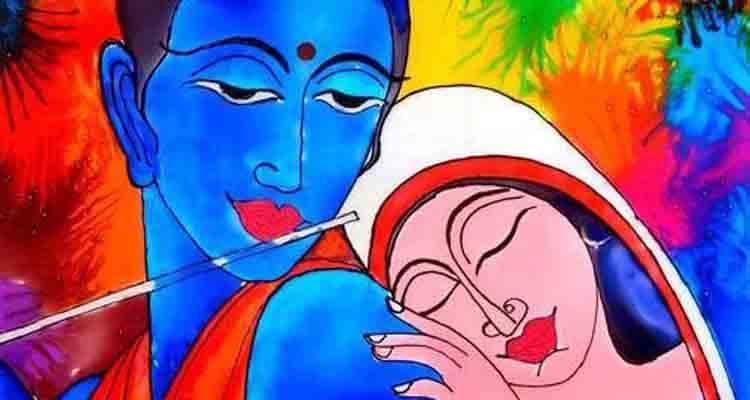Who is Satyabhama?
Satyabhama’s volatile temperament may be attributed to the fact that she is an incarnation of the earth goddess, Bhudevi. Unlike the playful yet docile Lakshmi, Bhudevi is a primal and wild woman archetype. Such women, even if married, submit to no one’s authority. Indeed, in southern India, the idea of Vishnu having two wives – Sridevi (Lakshmi) and Bhudevi is rather popular. It draws from the myth of the Varaha avatar. Vishnu in his boar form rescued the earth goddess from under the primordial seas, where the demon, Hiranyaksha had captured her. While Bhudevi takes her rescuer as her husband in this story, she has a chance to return the favour in her form as Satyabhama.
The lustre of truth
We don’t know much about the birth of Satyabhama, except that she is the daughter of Satrajit – a Yadava king and the royal treasurer of Dwarka. Krishna’s tussle with Satrajit over the Syamantaka gem is another story, but it culminates in Krishna’s marriage to all three daughters of Satrajit – Vratini, Prasvapini, and Satyabhama. It is interesting that though Krishna refuses to take the invaluable Syamantaka gem from Satrajit, he gets Satyabhama in the bargain, whose name means ‘the lustre of truth’.
Co-wife, co-warrior
Though a co-wife among Krishna’s eight principal spouses (together known as the Ashta Bharyas), Satyabhama refuses to be a ‘good lil wife’ and stay at home. As a true ardhangini (literally, one half of the spouse), she demanded to accompany Krishna everywhere, including the battlefield. Krishna indulged her, knowing that she was not only a trained and capable warrior but also part of a larger drama destined to unfold. A powerful asura, Naraka a.k.a. Bhauma had once obtained a boon from Brahma that no one would be able to kill him except his mother, the earth goddess Bhudevi. Drunk on power, Narakasura vanquished all kings and gods, defeated Indra and took hold of Amaravati. He even had the audacity to steal the mother of all gods – Aditi’s earrings and kidnapped 16,000 princesses. The gods and sages summoned Krishna for help, and he decided to go to war with Narakasura. A great fight ensued and at one point Krishna is injured and rendered unconscious by Narakasura. This enraged Satyabhama and charging with all her fury, she attacked and killed Narakasura. As an incarnation of Bhudevi (and hence, Narakasura’s mother), she was able to rid the earth of his terrors, while honouring Brahma’s boon. But as he lay dying, Narakasura asked his ‘mother’ for yet another boon. That the world may remember him not with malice but joy, and that the day of his death is celebrated each year. This myth is the reason behind the ritual celebration of Naraka Chaturdashi on Diwali.
Was Satyabhama jealous of other wives of Krishna?
Satyabhama’s competitive spirit did not stop at the battlefield, and the fight for attention was a constant in her life. There are numerous stories of her rivalry with Rukmini, but they are crafted consistently to show how the former’s selfless love is better than Satyabhama’s possessiveness. A demanding woman is not idealised in patriarchal mythologies, but today’s feminists will admire her feisty spirit. The story of the Parijata tree is one such example. Once, Krishna brought Rukmini a gift of a few flowers from the divine Parijata tree. Driven by jealousy (or a need for equality perhaps?), Satyabhama demanded that her husband bring her those flowers too. Krishna indulged her again and offered to bring her not just flowers but the entire Parijata tree. He takes her along on the Garuda and goes to Amaravati, Indra’s abode, where the Parijata tree is. Satyabhama uproots the tree, and after a big tussle, the tree is taken back to earth and planted in Satyabhama’s garden, and she is happy – at least for some time. She feels victorious, but her pride comes before a fall. The branches grow such that the flowers all fall in Rukmini’s garden and Satyabhama has to eat humble pie. In the tulabharam incident too, Rukmini bests her. One can’t help but feel bad for Satyabhama whose manner of seeking love may seem selfish but is no less ardent. This woman is true to her nature and voices her need for love. She is neither shy nor patient and won’t be tamed by social expectations. Satyabhama is a hard woman to love, but definitely a worthy one. Do you agree?


